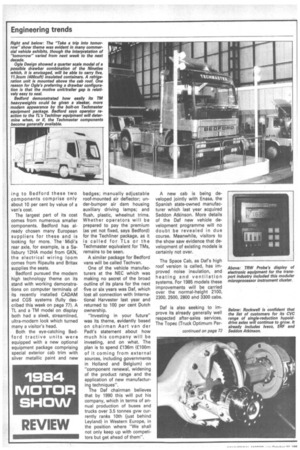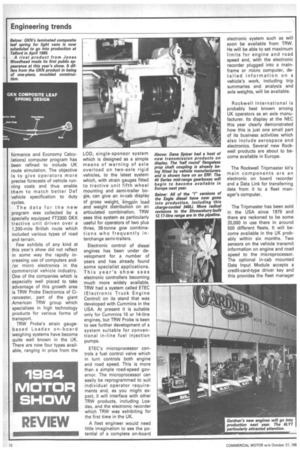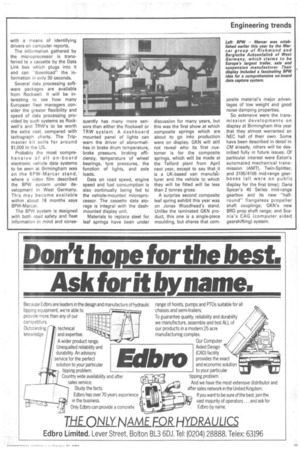Days of future passed
Page 75

Page 76

Page 78

Page 79

If you've noticed an error in this article please click here to report it so we can fix it.
Tim Blakemore spent much of his time at the Motor Show looking at how exhibitors perceive the future. There was innovation aplenty, and across a wide range of vehicles and components
"TAKE a trip into tomorrow" was the theme of the Society of Motor Manufacturers and Traders for this year's Motor Show and it turned out to be an unusually appropriate one for many commercial vehicle and component manufacturers. The number of exhibitors who chose to place more emphasis on what they are planning to do rather than what they have done already was greater at this show than at any other I have attended.
"The future is here", boldly proclaimed the Lucas Industries stand, while Eaton invited visitors to "take a trip into tomorrow's technology". And the striking size and appearance of these and other stands, such as those of the GKN group and Rockwell International for example, underlined another trend at the National Exhibition Centre. Many component manufacturers are no longer prepared to take so much of a back seat to the chassis manufacturers as has been the tradition.
Engine, transmission and suspension makers in particular are noticeably seeking higher profiles.
Of all the vehicle manufacturers at the show, Bedford is the one which appears to be working hardest to change its image. The "take a trip into tomorrow" theme might have been chosen by the Bedford stand designers to suit its "high-tech" look.
Now that GM's Truck and Bus Group is up and running and Bedford is an integral part of it, the Luton-based manufacturer is keen to shake off the image it acquired while it was a Vauxhall Motors subsidiary — that of a rather staid middleweight manufacturer which could never quite find the right formula to catch the imagination of large numbers of buyers of heavyweight tractive units and whose success at the lighter end of the commercial vehicle market was also limited.
The Astra van has already transformed Bedford's fortunes in the UK light van market and there is good reason to suppose that the new model, with its revised body style, which gives greater load volume as well as improved aerodynamics, will consolidate that success story.
From January 1985 Bedford will have a new van range that slots in between its car-derived model and the CF2. Two prototypes of the Midi, a 12-seater bus and a long wheelbase van, were on display at Birmingham. The full range of 16 variants will be phased into production on the new van line at Luton next year.
A first glance at the Midi's specification leaves one surprised that as much as 60 per cent (by value) of it is currently sourced in the EEC and, according to GM's agreement with the Department of Trade and Industry, this will rise to 80 per cent in two years.
The engines (a 1-8-litre petrol and 2-litre diesel) and gearboxes come direct from Isuzu of Japan (a company in which GM has a 41 per cent stake) and, despite some relatively minor modifications at the front to suit EEC and ECE impact tests, the body panels are clearly the same as those of lsuzu's WFR van range.
How, then, does 60 per cent of the Midi come from Europe? The answer provides an insight into the range of manufacturing options that will open up for GM as the plans for its Truck and Bus Group come to fruition.
Isuzu's press tools have been duplicated for the Midi, to enable its panels to be pressed in Britain. Clearly it would not have made economic sense to duplicate engine and gearbox manufacture and besides, surprising as it may seem, accord ing to Bedford these two components comprise only about 10 per cent by value of a van's cost.
The largest part of its cost comes from numerous smaller components. Bedford has already chosen many European suppliers for these and is looking for more. The Midi's rear axle, for example, is a Salisbury 12HA model from GKN, the electrical wiring loom comes from Ripaults and Britax supplies the seats.
Bedford pursued the modern high technology theme on its stand with working demonstrations on computer terminals of its recently installed CADAM and CGS systems (fully described this week on page 77). A TL and a TM model on display both had a sleek, streamlined, ultra-modern look which turned many a visitor's head.
Both the eye-catching Bedford tractive units were equipped with a new optional equipment package comprising special exterior cab trim with silver metallic paint and new badges; manually adjustable roof-mounted air deflector; un der-bumper air dam housing auxiliary driving lamps; and flush, plastic, wheelnut trims.
Whether operators will be prepared to pay the premium (as yet not fixed, says Bedford) for the Techliner package, as it is called for TLs or the Techmaster equivalent for TMs, remains to be seen.
A similar package for Bedford vans will be called Techvan.
One of the vehicle manufacturers at the NEC which was making no secret of the broad outline of its plans for the next five or six years was Daf, which lost all connection with International Harvester last year and returned to 100 per cent Dutch ownership.
"Investing in your future" was its theme, evidently based on chairman Aart van der Padt's statement about how much his company will be investing, and on what. The plan is to spend £136m (£100m of it coming from external sources, including governments in Holland and Belgium) on "component renewal, widening of the product range and the application of new manufacturing techniques".
The Daf chairman believes that by 1990 this will put his company, which in terms of annual production of buses and trucks over 3.5 tonnes gvw currently ranks 10th (just behind Leyland) in Western Europe, in the position where "We shall not only keep up with competitors but get ahead of them". A new cab is being developed jointly with Enasa, the Spanish state-owned manufacturer which last year acquired Seddon Atkinson. More details of the Daf new vehicle development programme will no doubt be revealed in due course. Meanwhile, visitors to the show saw evidence that development of existing models is certainly not over.
The Space Cab, as Daf's high roof version is called, has improved noise insulation, and heating and ventilation systems. For 1985 models these improvements will be carried over the normal-height 2100, 2300, 2500, 2800 and 3300 cabs.
Daf is also seeking to improve its already generally well respected after-sales services, The Topec (Truck Optimum Per formance and Economy Calculations) computer program has been refined to include UK route simulation. The objective is to give operators more precise forecasts of vehicle running costs and thus enable them to match better Daf vehicle specification to duty cycles.
The data for the new program was collected by a specially equipped FT3300 DKX tractive unit driven over a 1,200-mile British route which included various types of road and terrain.
Few exhibits of any kind at this year's show did not reflect in some way the rapidly increasing use of computers and/or micro electronics in the commercial vehicle industry. One of the companies which is especially well placed to take advantage of this growth area is TRW Probe Electronics of Cirencester, part of the giant American TRW group which specialises in high technology products for various forms of transport.
TRW Probe's strain gaugebased Loadax on-board weighing systems have become quite well known in the UK. There are now four types available, ranging in price from the
LOD, single-sponsor system which is designed as a simple means of warning of axle overload on two-axle rigid vehicles, to the latest system which, with strain gauges fitted to tractive unit fifth wheel mounting and semi-trailer bogie, can give an in-cab display of gross weight: kingpin 'load and weight distribution on an articulated combination. TRW sees this system as particularly useful for operators of two plus three, 38-tonne gcw combinations who frequently interchange semi-trailers.
Electronic control of diesel engines has been under development for a number of years and has already found some specialist applications. This year's show sees electronic controllers becoming much more widely available. TRW had a system called ETEC (Electronic Truck Engine Control) on its stand that was developed with Cummins in the USA. At present it is suitable only for Cummins 10 or 14-litre engines, but TRW Probe is keen to see further development of a system suitable for conventional in-line fuel injection pumps.
ETEC's microprocessor controls a fuel control valve which in turn controls both engine and road speed. This is more than a simple road-speed governor. The microprocessor can easily be reprogrammed to suit individual operator requirements and, as you might expect, it will interface with other TRW products, including Loadax, and the electronic recorder which TRW was exhibiting for the first time in the UK.
A fleet engineer would need little imagination to see the potential of a complete on-board Above: Dana Spicer had a host of new transmission products on display. The 'half round' flangeless prop shaft coupling is already being fitted by vehicle manufacturers and is shown here on an ERE. The 40 Series mid-range gearboxes will begin to become available in Europe next year.
Below: All of the versions of the Eagle diesel have now gone into production, including this charge-cooled 340LL More radical revisions to the Shrewsbury-built 12.17-litre range are in the pipeline. electronic system such as will soon be available from TRW. He will be able to set maximum limits for engine and road speed and, with the electronic recorder plugged into a mainframe or micro computer, detailed information on a vehicle's work, including trip summaries and analysis and axle weights, will be available.
Rockwell International is probably best known among UK operators as an axle manufacturer. Its display at the NEC this year clearly demonstrated how this is just one small part of its business activities which also include aerospace and electronics. Several new Rockwell products are about to become available in Europe.
The Rockwell Tripmaster kit's main components are an electronic on board recorder and a Data Link for transferring data from it to a fleet manager's computer.
The Tripmaster has been sold in the USA since 1979 and there are reckoned to be some 20,000 in use there in around 500 different fleets. It will become available in the UK probably within six months. Two sensors on the vehicle transmit information on engine and road speed to the microprocessor. The optional in-cab mounted Data Input Module accepts a credit-card-type driver key and this provides the fleet manager with a means of identifying drivers on computer reports.
The information gathered by the microprocessor is transferred to a cassette by the Data Link box which plugs into it and can "download" the information in only 30 seconds.
Several data processing software packages are available from Rockwell. It will be interesting to see how many European fleet managers consider the greater flexibility and speed of data processing provided by such systems as Rockwell's and TRW's to be worth the extra cost, compared with tachograph charts. The Tripmaster kit sells for around $1,000 in the US.
Probably the most comprehensive of all on-board electronic vehicle data systems to be seen at Birmingham was on the BPW-Marcar stand, where a video film described the BPW system under development in West Germany. This may become available within about 18 months says BPW-Marcar.
The BPW system is designed with both road safety and fleet information in mind and conse quently has many more sensors than either the Rockwell or TRW system. A dashboard mounted panel of lights can warn the driver of abnormalities in brake drum temperature, brake pressure, braking efficiency, temperature of wheel bearings, tyre pressures, the function of lights, and axle loads.
Data on road speed, engine speed and fuel consumption is also continually being fed to the vehicle-mounted microprocessor. The cassette data storage is integral with the dashmounted display unit.
Materials to replace steel for leaf springs have been under discussion for many years, but this was the first show at which composite springs which are about to go into production were on display. GKN will still not reveal who its first customer is for the composite springs, which will be made at the Telford plant from April next year, except to say that it is a UK-based van manufgbturer and the vehicle to which they will be fitted will be less than 2 tonnes gross.
A surprise second composite leaf spring exhibit this year was on Jonas Woodhead's stand. Unlike the laminated GKN product, this one is a single-piece moulding, but shares that corn posite material's major advantages of low weight and good noise damping properties.
So extensive were the transmission developments on display at Birmingham this year that they almost warranted an NEC hall of their own. Some have been described in detail in CM already, others will be described fully in future issues. Of particular interest were Eaton's automated mechanical transmission (AMT), Twin-Splitter, and 3105/4106 mid-range gearboxes (all were on public display for the first time); Dana Spicer's 40 Series mid-range gearbox and its new "halfround" flangeless propeller shaft couplings; GKN's new BRD prop shaft range; and Scania's CAG {computer aided gearshifting) system.


















































































































